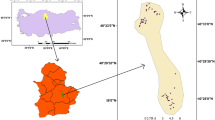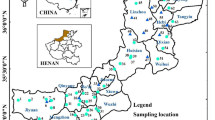Abstract
Owing to limited surface water during a long-term drought, this work attempted to locate clean and safe groundwater in the Choushui River alluvial fan of Taiwan based on drinking-water quality standards. Because aquifers contained several pollutants, multivariate indicator kriging (MVIK) was adopted to integrate the multiple pollutants in groundwater based on drinking- and raw-water quality standards and to explore spatial uncertainty. According to probabilities estimated by MVIK, safe zones were determined under four treatment conditions—no treatment; ammonium–N and iron removal; manganese and arsenic removal; and ammonium–N, iron, manganese, and arsenic removal. The analyzed results reveal that groundwater in the study area is not appropriate for drinking use without any treatments because of high ammonium–N, iron, manganese, and/or arsenic concentrations. After ammonium–N, iron, manganese, and arsenic removed, about 81.9–94.9% of total areas can extract safe groundwater for drinking. The proximal-fan, central mid-fan, southern mid-fan, and northern regions are the excellent locations to pump safe groundwater for drinking after treatment. Deep aquifers of exceeding 200 m depth have wider regions to obtain excellent groundwater than shallow aquifers do.








Similar content being viewed by others
References
Appelo, C. A. J., & Postma, D. (1993). Geochemistry, groundwater and pollution (pp. 239–295). VT, USA: A.A. Balkema Publishers.
Castrignanò, A., Goovaerts, P., Lulli, L., & Bragato, G. (2000). A geostatistical approach to estimate probability of occurrence of Tuber melanosporum in relation to some soil properties. Geoderma, 98, 95–113.
Survey, C. G. (1999). Project of Groundwater Monitoring Network in Taiwan during First Stage-research Report of Choushui River Alluvial Fan. Taiwan: Water Resources Bureau. 383 pp.
Chen, W. F., & Liu, T. K. (2003). Dissolved oxygen and nitrate of groundwater in Choushui Fan-Delta, western Taiwan. Environmental Geology, 44(6), 731–737.
D'Alessandro, W., Bellomo, S., Parello, F., Brusca, L., & Longo, M. (2008). Survey on fluoride, bromide and chloride contents in public drinking water supplies in Sicily (Italy). Environmental Monitoring and Assessment, 145(1–3), 303–313.
Deutsch, C. V. (2002). Geostatistical reservoir modeling (pp. 124–152). New York: Oxford University Press.
Deutsch, C. V., & Journel, A. G. (1998). GSLIB: Geostatistical Software Library and User's Guide (2nd ed.). New York: Oxford University Press.
Diodato, N., & Ceccarelli, M. (2004). Multivariate indicator kriging approach using a GIS to classify soil degradation for Mediterranean agricultural lands. Ecological Indicators, 4(3), 177–187.
Goovaerts, P. (1997). Geostatistics for natural resources evaluation (pp. 259–368). New York: Oxford University Press.
Goovaerts, P., AvRuskin, G., Meliker, J., Slotnick, M., Jacquez, G., & Nriagu, J. (2005). Geostatistical modeling of the spatial variability of arsenic in groundwater of southeast Michigan. Water Resources Research, 41. doi:10.1029/2004WR003705.
Halvorson, J. J., Smith, J. L., & Papendick, R. I. (1996). Integration of multiple soil parameters to evaluate soil quality: A field example. Biology and Fertility of Soils, 21(3), 207–214.
Harada, K. (2008). Climate change mitigation in a sustainable world-findings of the IPCC 4th assessment report. AIST Today, 28, 10–11.
Jang, C. S., & Chen, J. S. (2009). Probabilistic assessment of groundwater mixing with surface water for agricultural utilization. Journal of Hydrology, 376(1–2), 188–199.
Jang, C. S., Chen, S. K., & Lin, C. C. (2008). Using multivariate indicator kriging to assess groundwater quality for irrigation in the aquifers of the Choushui River alluvial fan. Hydrological Processes, 22(22), 4477–4489.
Jang, C. S., & Liu, C. W. (2005). Contamination potential of nitrogen compounds in the heterogeneous aquifers of the Choushui River alluvial fan, Taiwan. Journal of Contaminant Hydrology, 79, 135–155.
Jang, C. S., Liu, C. W., Lin, K. H., Huang, F. M., & Wang, S. W. (2006). Spatial analysis of potential carcinogenic risks associated with ingesting arsenic in aquacultural tilapia (Oreochromis mossambicus) in blackfoot disease hyperendemic areas. Environmental Science and Technology, 40, 1707–1713.
Jang, C. S., Liu, C. W., Lu, K. L., & Lin, C. C. (2007). Delimitation of arsenic-contaminated groundwater using risk-based indicator approaches around blackfoot disease hyperendemic areas of southern Taiwan. Environmental Monitoring and Assessment, 134, 293–304.
Juang, K. W., & Lee, D. Y. (1998). Simple indicator kriging for estimating the probability of incorrectly delineating hazardous areas in a contaminated site. Environmental Science and Technology, 32, 2487–2493.
Knobeloch, L., Salna, B., Hogan, A., Postle, J., & Anderson, H. (2000). Blue babies and nitrate-contaminated well water. Environmental Health Perspectives, 108(7), 675–678.
Liu, C. W., Jang, C. S., & Liao, C. M. (2004). Evaluation of arsenic contamination potential using indicator kriging in the Yun-Lin aquifer (Taiwan). Science of the Total Environment, 321, 173–188.
Liu, C. W., Wang, S. W., Jang, C. S., & Lin, K. H. (2006). Occurrence of arsenic in groundwater of the Choshui river alluvial fan, Taiwan. Journal of Environmental Quality, 35, 68–75.
Oyedele, D. J., Amusan, A. A., & Obi, A. O. (1996). The use of multivariate indicator kriging technique for assessment of the suitability of an acid soil for maize. Tropical Agriculture, 73(4), 259–263.
Packham, R. F. (1992). Public health and regulatory aspects of inorganic nitrogen compounds in drinking water. Water Supply, 10(3), 1–6.
Saisana, M., Dubois, G., Chaloulakou, A., & Spyrellis, N. (2004). Classification criteria and probability risk maps: Limitations and perspectives. Environmental Science and Technology, 38, 1275–1281.
Smith, J. L., Halvorson, J. J., & Papendick, R. I. (1993). Using multivariate indicator kriging for evaluating soil quality. Soil Science Society of America Journal, 57, 743–749.
Taiwan Sugar Company. (1997). Establishment and operational management of groundwater monitoring network (pp. 2–12). Taiwan: Water Resources Bureau.
Taiwan Sugar Company. (2004). Groundwater quality by the Taiwan groundwater monitoring network (1/2) (pp. 6-1–6-65). Taiwan: Water Resources Bureau.
Tseng, W. P. (1977). Effects and dose-response relationships of skin cancer and blackfoot disease with arsenic. Environmental Health Perspectives, 19, 109–119.
Van Meirvenne, M., & Goovaerts, P. (2001). Evaluating the probability of exceeding a site-specific soil cadmium contamination threshold. Geoderma, 102, 75–100.
Wang, S. W., Liu, C. W., & Jang, C. S. (2007). Factors responsible for high arsenic concentrations in two groundwater catchments at Taiwan. Applied Geochemistry, 22, 460–476.
Zabin, S., Foaad, M. A., & Al-Ghamdi, A. (2008). Non-carcinogenic risk assessment of heavy metals and fluoride in some water wells in the Al-Baha region, Saudi Arabia. Human and Ecological Risk Assessment, 14(6), 1306–1317.
Zeng, G. M., Liang, J., Guo, S. L., Shi, L., Xiang, L., Li, X. D., et al. (2009). Spatial analysis of human health risk associated with ingesting manganese in Huangxing Town, Middle China. Chemosphere, 77(3), 368–375.
Acknowledgments
The author would like to thank the National Science Council of the Republic of China for financially supporting this research under the Contract No. NSC 99-2914-I-424-002-A1.
Author information
Authors and Affiliations
Corresponding author
Rights and permissions
About this article
Cite this article
Jang, CS. Regional assessment of groundwater quality for drinking purpose. Environ Monit Assess 184, 3063–3075 (2012). https://doi.org/10.1007/s10661-011-2171-y
Received:
Accepted:
Published:
Issue Date:
DOI: https://doi.org/10.1007/s10661-011-2171-y




